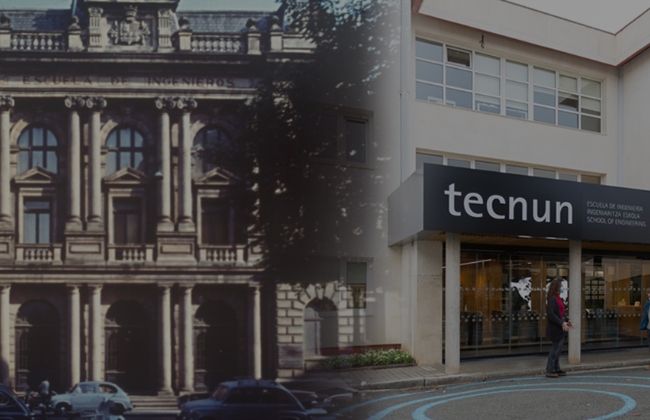The University of Navarra was founded in 1952, promoted by Saint Josemaría Escrivá, founder of Opus Dei. Since then, many milestones have marked its history, marked by the search for excellence in teaching and research, always at the service of people and society.
-
1952
The Estudio General de Navarra is born
goal The University of Navarre, founded by Saint Josemaría Escrivá, was born as the Estudio General de Navarra in April 1952 with the aim of taking the first steps in the creation of a School of Law in Pamplona, with the aim of creating a Law School in Pamplona. On 17 October, with an academic ceremony held in the Salón del committee Foral de Navarra, in the Diputación.
The first law course begins in the Chamber of Accounts with 48 students and 8 teachers.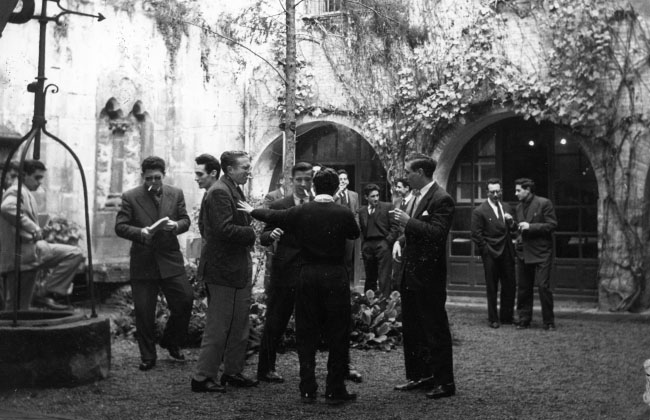
-
1954
Ismael Sánchez Bella, new President. The Schools of Medicine and Nursing are born
Ismael Sánchez Bella was appointed President of the Estudio General de Navarra on October 7.Full Professor from History of Law, he arrived at the University of Navarra in 1952, becoming one of the first professors of the academic center. He was the first director of the School of Law until his appointment as President of the Estudio General.
In addition, that same year the Schools of Medicine and Nursing were created, future Schools.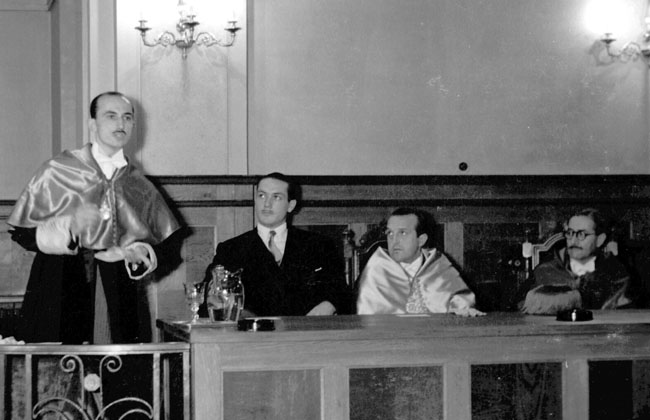
-
1955
The School of Humanities and Social Sciences
The School of Humanities and Social Sciences was born, on the top floor of the Museum of Navarre, in classrooms loaned by the Provincial Council. The Medicine students, in their second year, study subjects that require practical work, facilities and laboratories, so they move to a small building in the Hospital de Navarra and to laboratory de Sanidad, on loan from the Provincial Council. Nursing students did their practical training at the General Hospital of Navarre.
In the 1955/56 academic year, the number of students enrolled was 184.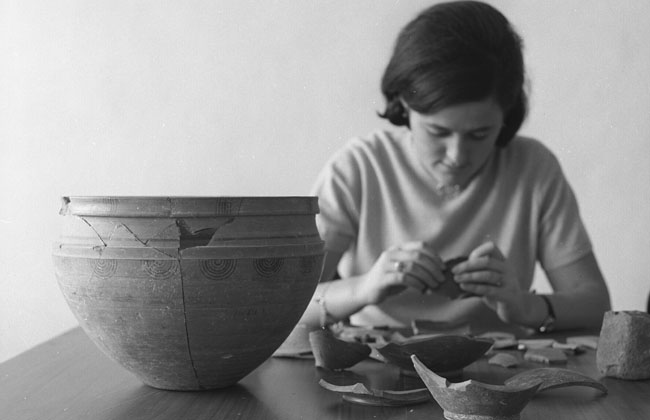
-
1958
IESE's first programme and creation of the Institute of Journalism
IESE's first programme in Barcelona opens on 25 November, with 20 company executives enrolled.
Management schools were not well known outside the United States. The establishment of these programmes is therefore a milestone in the history of executive education in Spain.
This same year, the Institute of Journalism begins its activity.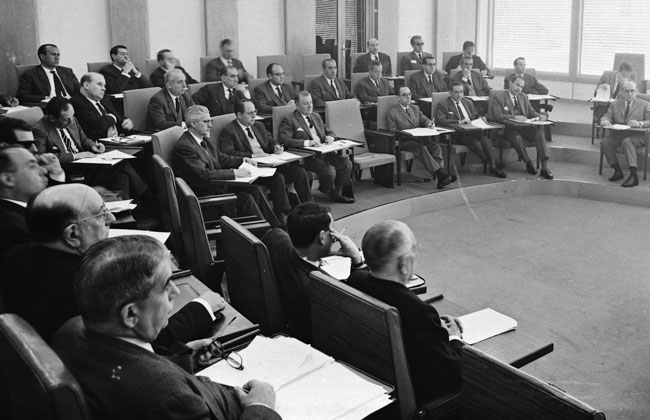
-
1959
Birth of the Friends Association
The Association of Friends of the University is born, with the aim of collaborating with the support of the academic centre.
Since its constitution, the contributions of the Friends of the University have enabled the provision of infrastructures for teaching and research, the promotion of Clínica Universidad de Navarra and, since 1975, the granting of scholarships for researchers.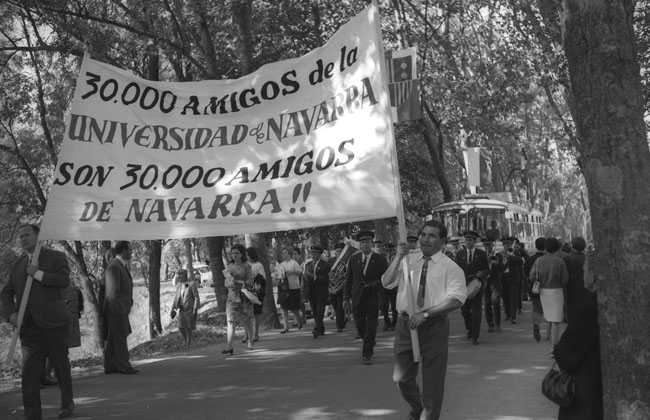
-
1960
Erection as a University and appointment of José Mª Albareda as the President
José Mª Albareda, Full Professor of the University of Madrid, takes possession of his position as President on February 2.
On August 6, the Holy See established the Estudio General de Navarra as a university, and a decree of the Congregation for Seminaries and Universities named its founder, Josemaría Escrivá, Chancellor . On October 25, he received the title of Adopted Son of Pamplona, degree scroll .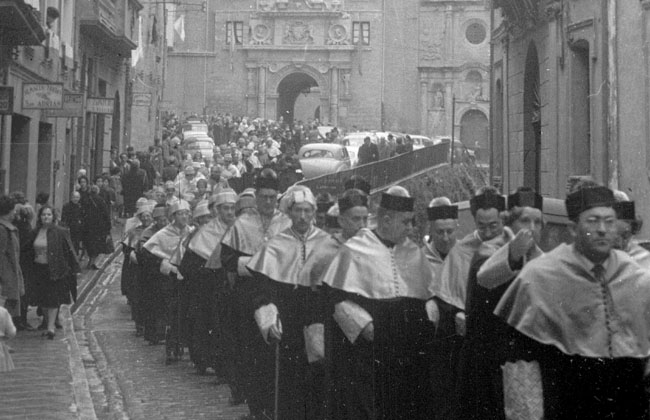
-
1961
The institute of modern languages and the technical school of Industrial Engineers are born.
institute of modern languages, which taught English, French and German at the Museum of Navarre, began its work. The number of students rose to 300. Thomas Gilgut, graduate from Harvard University, was elected coordinator of the body professor. He was at the head of the Institute until 1968.
The technical school for Industrial Engineers begins in San Sebastián, in a building provided by the Diputación de Guipúzcoa.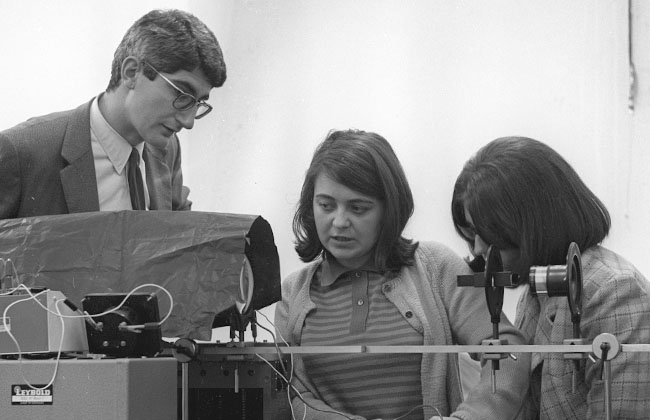
-
1962
Civilian recognition and first phase of the Clinic
The state recognises the civil effects of studies at the university, putting them on a fully equal footing with those of state institutions. This is the first time that studies at a non-state institution have been recognised in this way.
Cardinal Ottaviani, then Prefect of the Sacred Congregation of the Holy official document, inaugurates the first phase of the Postgraduate School, the first University Clinic project . It starts up with 19 beds.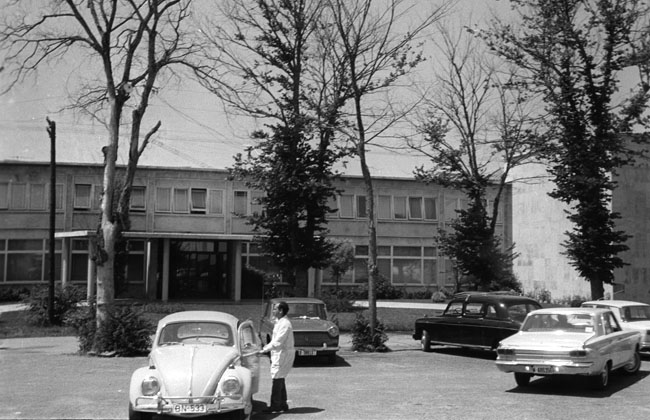
-
1963
Higher Institute of Secretarial Studies (ISSA)
The high school Superior de Secretariado (ISSA) is born, today called ISSA - School of Applied Management.
In 1963, the University of Navarra bought the palace Eva Enea (Villa Eva), located between the slopes of Aldapeta and San Roque in San Sebastian, to house the high school Superior School of Secretarial Studies. During these fifty years more than 3,000 students have passed through its classrooms.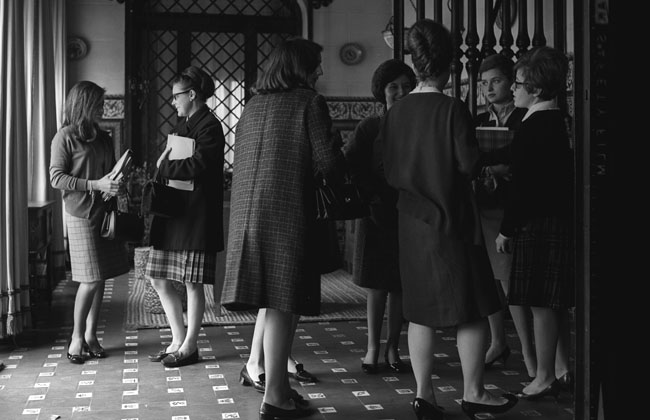
-
1964
First General Assembly of Friends and first Honorary Doctorates
IESE launches its MBA programme, under the guidance of a committee advisor established by Harvard Business School and IESE. It was the first two-year MBA in Europe.
In September of this year, studies begin at Schools in Science (Biology), Pharmacy, the School of Architecture and specialization program in Philosophy at School of Humanities and Social Sciences.
On Saturday 28 October, the Chancellor awarded for the first time the Degree de honorary doctor, to Miguel Sancho Izquierdo and Juan Cabrera y Felipe.
On 30 November, the Association of Friends holds its First General Assembly in Pamplona.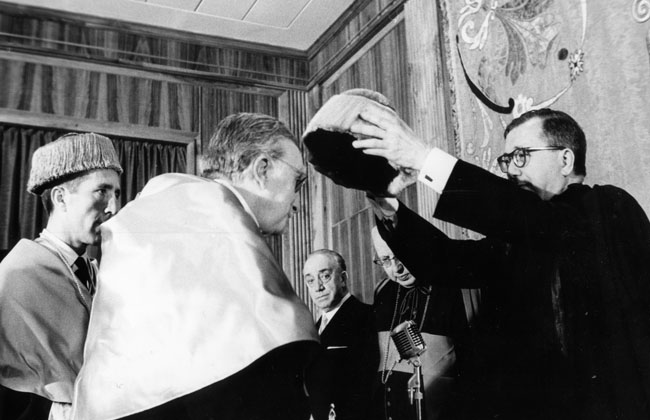
-
1966
Francisco Ponz , President
Francisco Ponz Piedrafita, Full Professor of Organography and Animal Physiology of the School of Sciences of the University of Barcelona, takes office as President
The high school of language and Spanish Culture (ILCE) is launched, and the construction of the Library Services of Humanities is completed.
On the feast of the Immaculate Conception, and with the dedication of 'Mother of Fair Love', the image of the Virgin is placed in the Shrine of Our Lady of Fair Love .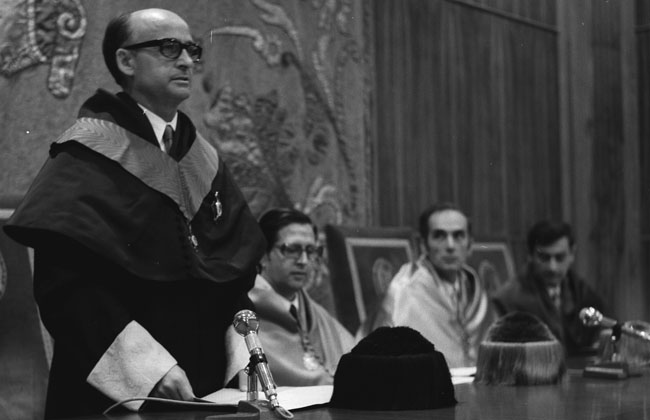
-
1967
Multitudinous Assembly of Friends and new Honorary Doctorates
The Association of Friends held a large General Assembly in Pamplona in October, attended by 30,000 people. The Chancellor celebrates a Mass in which he pronounces what is known as the "Homily of the campus".
This Assembly was preceded by the investiture ceremony of Degree of honorary doctor to Willy Onclin, Guilherme Braga da Cruz, Ralph M. Hower, Carlos Jiménez Díaz, Jean Roche and Otto B. Roegele. Roegele.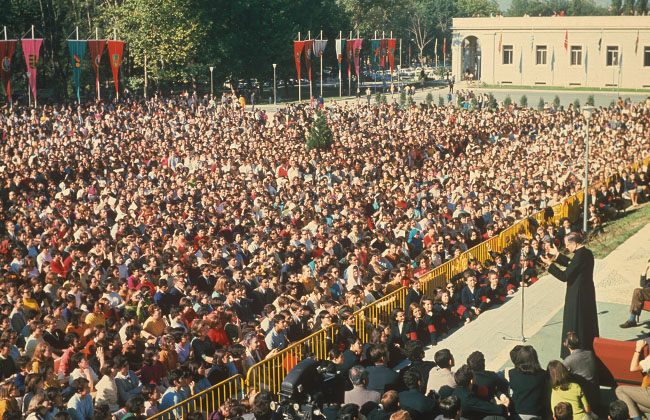
-
1969
School of Theology
The Institute of Theology, founded by Decree on 23 April 1967, by the Chancellor, becomes School. Its academic degrees have full canonical and civil validity.

-
1971
School of Information Science
The Institute of Journalism is upgraded to School of Information Sciences, following the process, initiated in 1969, to modify the General Education Act. In 1970/71, together with that of Navarra, Schools began in Madrid and Barcelona.
That same year, the installation of the first television studio for student internships began. It was put into operation the following year, 1972.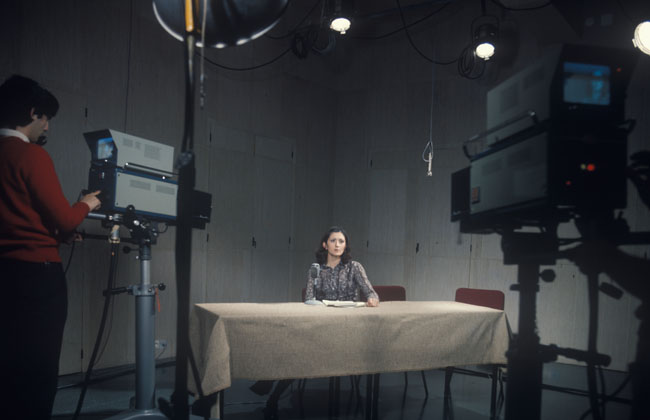
-
1972
The Chancellor visit the University of Navarra
In 1972 El Chancellor visit the University of Navarra to name Erich Letterer, Juan de Contreras y López de Ayala and Paul Ourliac honorary doctors. He also took advantage of his stay in Pamplona to hold important meetings with senior members of the Association of Friends and with professors of the university.
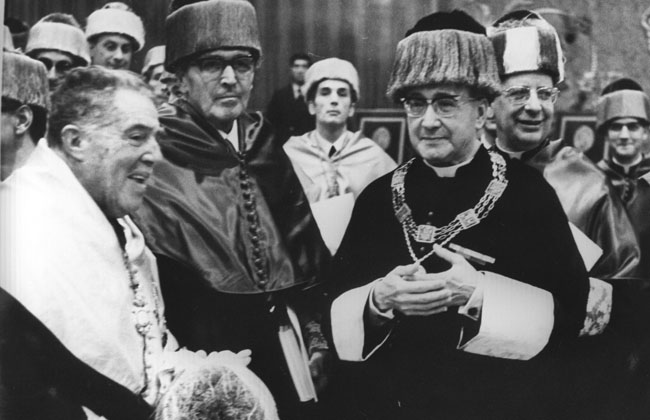
-
1974
IESE in Madrid and last visit of St Josemaría
IESE opens its campus in Madrid to meet the high demand for executive education in the Spanish capital.
That same year, the Athletic Club of the University of Navarra (CAUN), the only university club in Spain present in the Athletics League, is promoted to the First Division. CAUN had been founded in 1962 by Dr. Juan José González Iturri, a rehabilitation doctor and professor of medicine, with some first-year students.
The Chancellor visited the University for the last time. During his visit, he named Professor Lejeune and Monsignor Hengbach honorary doctors and held an unforgettable get-together with University professionals - professors, nurses, doctors, management and service staff, etc. - at Colegio Mayor Belagua.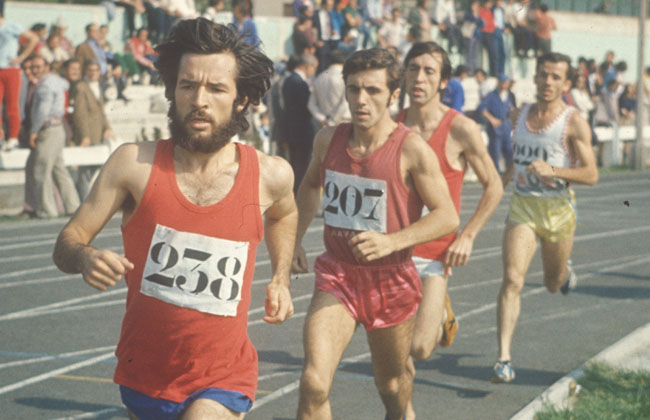
-
1975
The founder of the University passes away
Monsignor Escrivá de Balaguer, founder and first Chancellor of the University of Navarre, died in Rome on 26 June.
Monsignor Álvaro del Portillo is appointed Chancellor of the University of Navarre.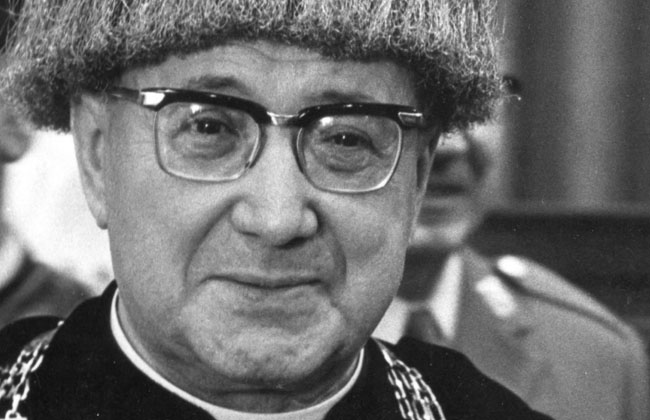
-
1976
Act in memoriam of Mons. Escrivá de Balaguer
Monsignor Álvaro del Portillo, Chancellor of the University of Navarre, presided on 16 June over an act in memoriam of Monsignor Escrivá de Balaguer, founder and first Chancellor of the University. His words included the vision that Mons. Escrivá's vision of the University of Navarra.
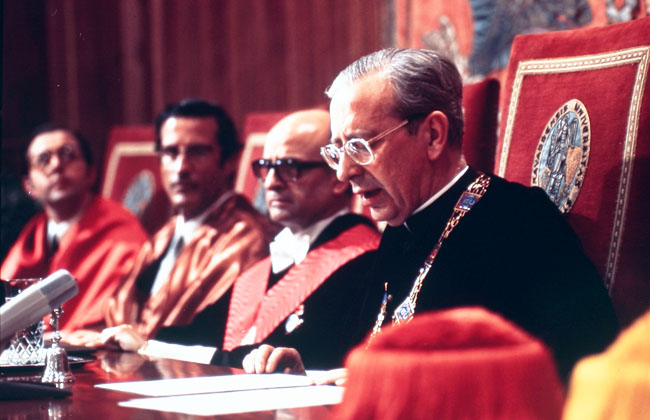
-
1979
Alfonso Nieto, new President
Professor Alfonso Nieto takes office as President on April 25. First Full Professor of business Informative in Spain, he had been director of the high school of Journalism between 1969 and 1972, and Dean of the already School of Information Sciences between 1972 and 1974. He was Vice President for two years (1977 to 1979), and President until 1991.
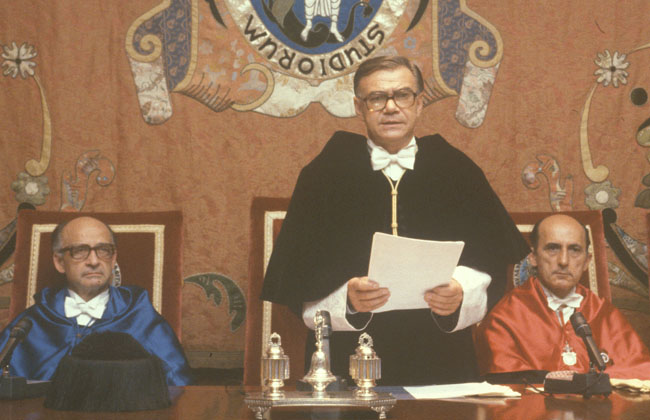
-
1981
25th Anniversary of Philosophy and Letters, and birth of the ICF
In October, events began to celebrate the 25th anniversary of the creation of the School of Humanities and Social Sciences, which already had Sections of History (1957), Philosophy (1964), Romance Philology (1965); and Educational Sciences and Geography and History (1973).
The Institute of Family Sciences was founded, with its headquarters at Los Nogales Building. Since then, it has been carrying out research and professor on marriage and the family.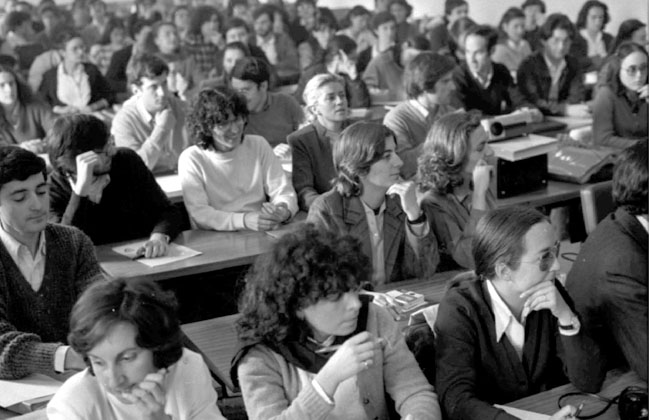
-
1982
Guipúzcoa Centre for Technical Studies and Research
The Centro de Estudios e Investigaciones Técnicas de Guipúzcoa (CEIT) is founded in San Sebastián, with José Mª Bastero as director general manager and Manuel Fuentes as director scientist.
It was set up as a non-profit centre, legally independent from the University, but linked to it by a common project . It soon became a centre under the auspices of the Basque Government and was declared to be of public utility.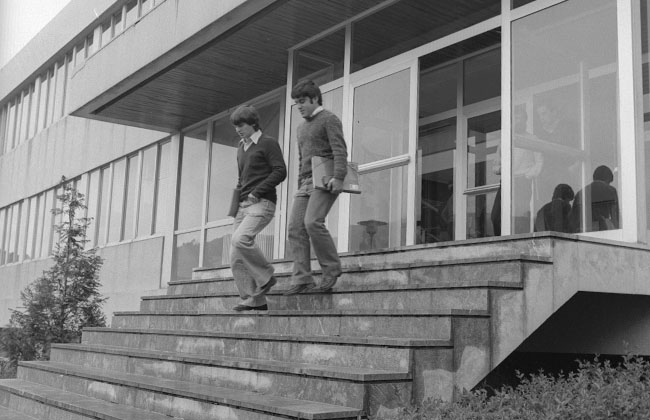
-
1984
Tribute to Dr. Eduardo Ortiz de Landázuri
On 13 October, the University paid tribute to Dr. Ortiz de Landázuri for his 25 years of teaching and service. The ceremony was presided over by Their Royal Highnesses the Duke and Duchess of Soria, Margarita Borbón and her husband, Dr. Carlos Zurita. A telex from the King and Queen of Spain was read out and they heartily joined in the ceremony.
Eduardo Ortiz de Landázuri, a prestigious doctor in Spain at the time, had joined the School de Medicina and the Clínica in 1958.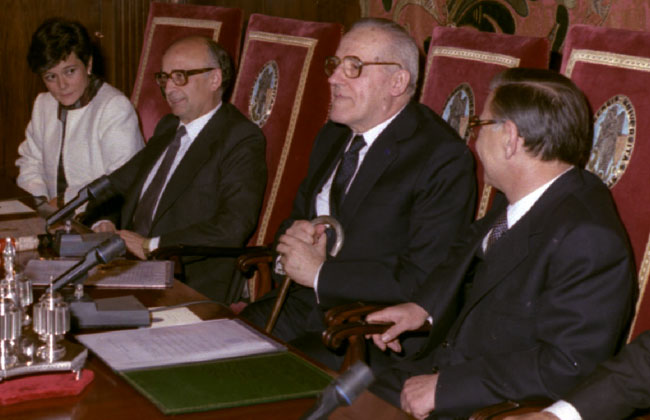
-
1986
First Silver Medals of the University
On 28 January, the feast of St. Thomas Aquinas, the University submission awarded 68 Silver Medals for the first time. The Medal marked with the number one is submission to Ismael Sánchez Bella, a pioneer of the University.
This distinction is awarded every year, on the same date, to all those who have been at the service of the University for 25 years or more.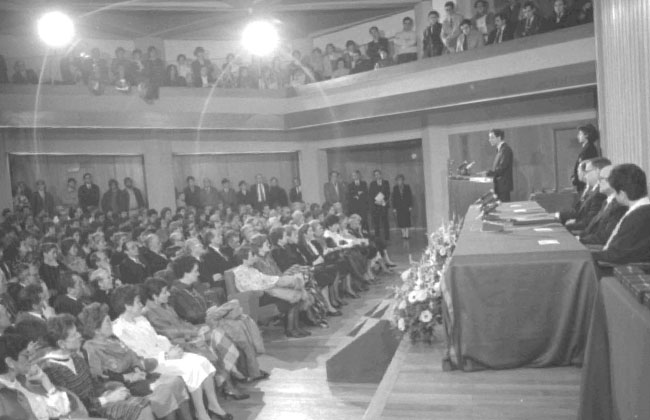
-
1987
The School for Economics and Business Studies is born.
The School of Economic and Business Sciences was created in 1987 with the hope of becoming a centre of reference for quality. With this goal on the horizon, Miguel Alfonso Martínez-Echevarría received his appointment as the first Dean of the School.
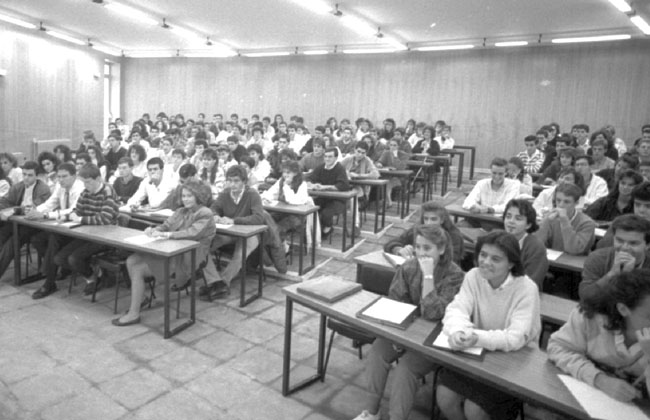
-
1988
The CIFA is born
The Centre for Research in Applied Pharmacobiology (CIFA), directed by Dr. Antonio Monge, is inaugurated on 9 September. Nearly two hundred managers and researchers from national and international pharmaceutical companies, political authorities and professors attended.
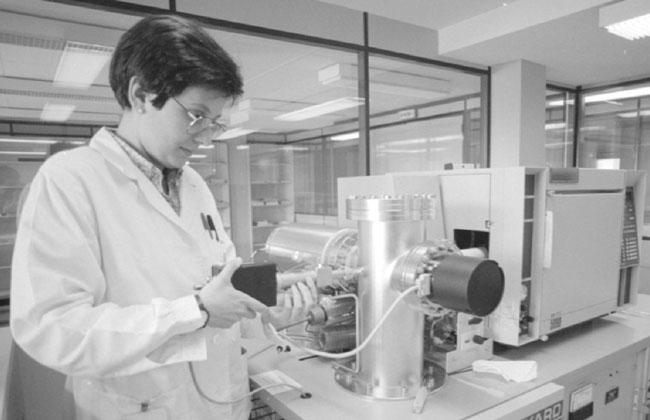
-
1990
Gold Medals and creation of the Ortiz-Echagüe Legacy
On 3 October, the University Gold Medals were awarded for the first time to Ismael Sánchez Bella, Juan Jiménez Vargas and Alvaro d'Ors. Dr. Ortiz de Landázuri had already received this distinction posthumously.
On the initiative of a group of students, group , Universitarios por la financial aid Social (UAS) was created.
In addition, with SEAT's sponsorship , the Ortiz Echagüe Legacy is installed in a specially equipped basement of Central Building.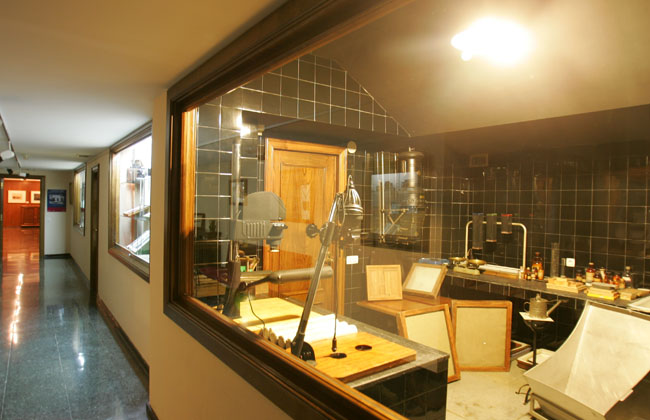
-
1991
Alejandro Llano, President; and new Gold Medals
The Full Professor of Metaphysics, Alejandro Llano, takes office as President on June 28. Llano had joined the faculty of the School de Philosophy y Letras in 1977, and between 1981 and 1989 he was its Dean.
During the opening of the 1991/92 academic year, the Gold Medals of the University were awarded to the nurse Carmen López, Professor Amadeo de Fuenmayor and Full Professor Francisco Ponz, President between 1966 and 1979.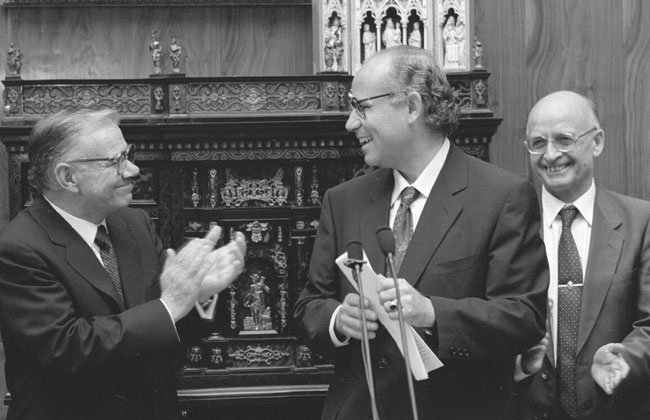
-
1993
The University Alumni Association is born
The Graduate Association of the University of Navarra is created. Among its objectives: to keep contact alive with the alumni and to offer students and graduates opportunities for training, relations and information.
Fifteen years later, Alumni was the largest association of alumni in Europe, with more than 21,000 members.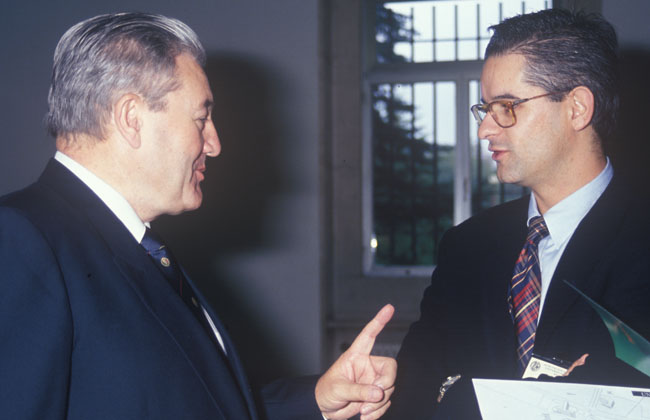
-
1994
Boosting research and recognising the Clinic
The PIUNA programme (Research Plan of the University of Navarra) is created.
The Clínica is chosen by more than 6,000 doctors from all over Spain as the Health Institution of the Decade.
The first Sports Day is held on 14 May.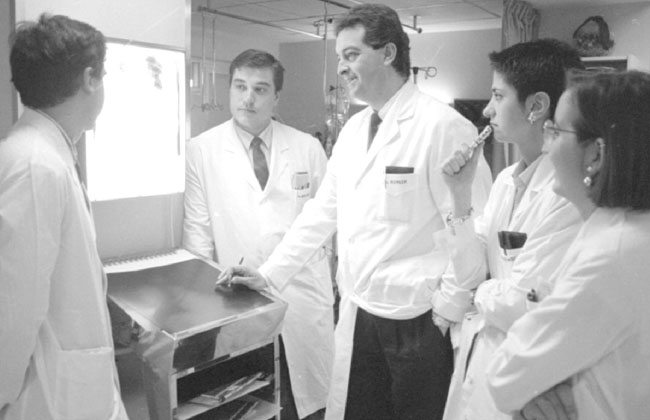
-
1996
José Mª Bastero, President
On 22 October, José Mª Bastero took office as President. A naval and industrial engineer and professor of Mechanics, he directed Tecnun (1978-1993) and the CEIT (1982-1993). In 1992 he had been appointed Vice President for Research.
CIFA, the first European university centre to obtain the official certification of 'Good practices of laboratory'.
The Centre for European Studies and the Josemaría Escrivá Documentation and Studies Centre are set up.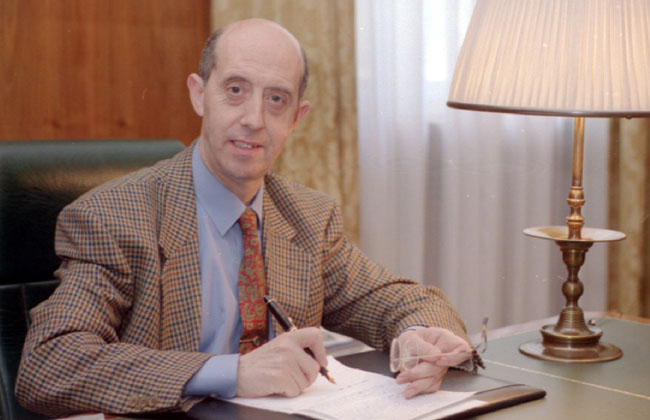
-
1997
Gold Medal of Navarre
On 3 December, the Day of Navarre, the President of the Regional Government, Miguel Sanz, submission awarded the Gold Medal of Navarre to the University. It was collected by President José Mª Bastero.
signature That same year, a new phase of the Clinic, the work of Leopoldo Gil Nebot, was inaugurated; the agreement with which the "classroom Aranzadi" of the School Law School was born was inaugurated; and the award Brajnovic, awarded by the School of Communication, was instituted.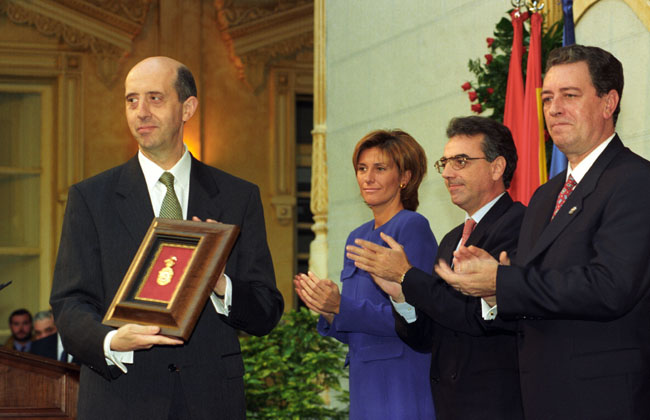
-
1998
New Honorary Doctors
On 31 January a new Investiture Ceremony of Honorary Doctors will be held: Joseph Ratzinger, Julian Simon, and Douwe Breimer.
The University submission its twelfth Gold Medal (in 1996 it had been awarded posthumously to Jesús Vázquez), to the Association of Friends.
This year, the Institutes of Anthropology and Ethics, and of Religious Sciences were born.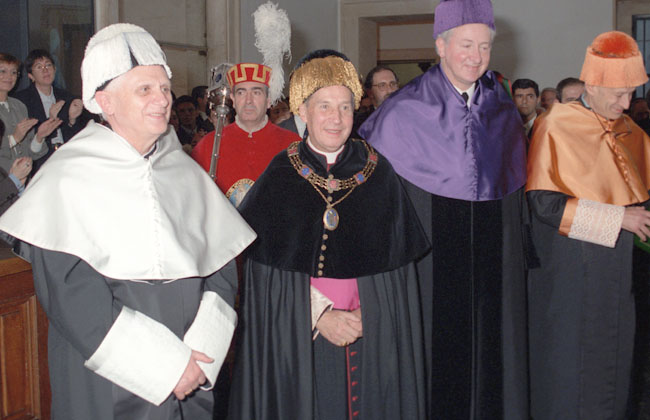
-
1999
98.3 Radio is born
Álvaro d'Ors, Full Professor of Roman Law, receives in the Monastery of Leyre, from the hands of Prince Felipe de Borbón, the award Príncipe de Viana, maximum award with which Navarra distinguishes the representatives of culture.
The 1st Ortiz de Landázuri Commemorative Lecture is held, given by Donnall Thomas, award Nobel Prize in Medicine in 1990.
On October 14, 98.3 Radio is inaugurated, the first university radio station in Spain with 24 hours of its own commercial programming.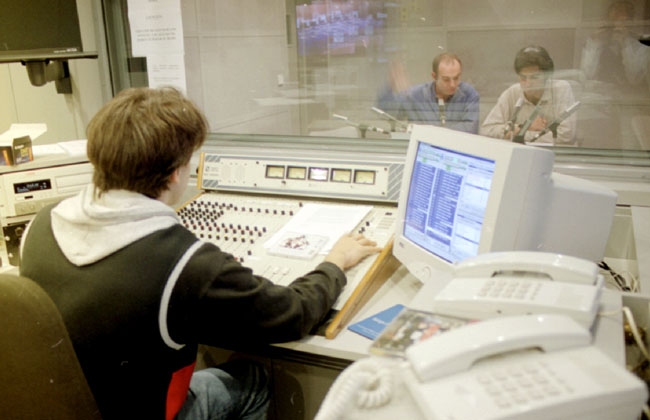
-
2000
Second teacher to receive the award Príncipe de Viana Award
Professor Concepción García Gaínza, the first Spanish professor of Art History, receives the award Príncipe de Viana de la Cultura, as did Álvaro d'Ors a year earlier.
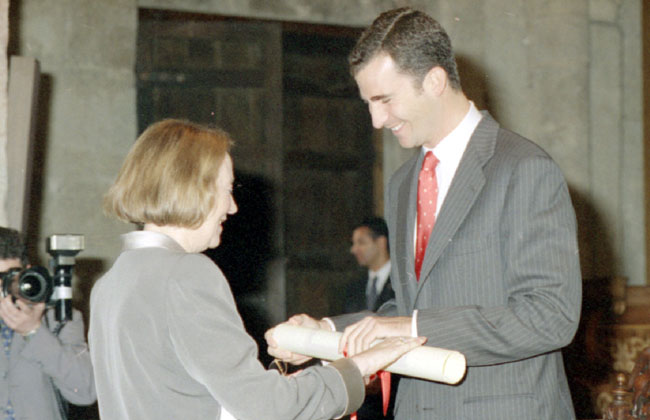
-
2002
Foundation stone of CIMA and canonisation of Saint Josemaría
The President, José Mª Bastero, submission posthumously awarded the University's Gold Medal to Antonio Valero, IESE's first general director .
On 11 April, José Mª Aznar, President of the Spanish Government, lays the first stone of the Centre for Applied Medical Research (CIMA).
On 6 October, the founder and first Chancellor of the University, Josemaría Escrivá, is canonised in Rome by Pope John Paul II.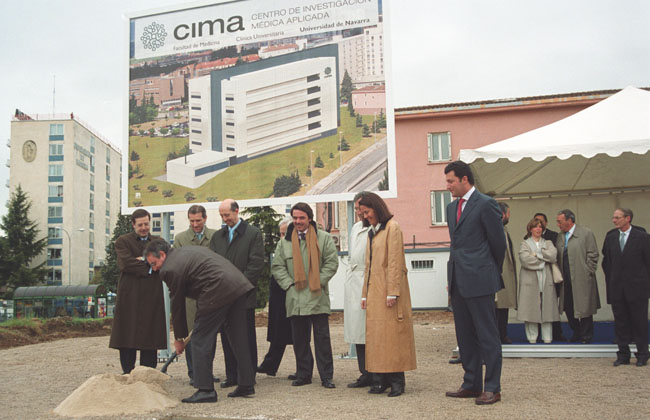
-
2005
Ángel J. Gómez-Montoro, new President
The Full Professor of Constitutional Law, Ángel J. Gómez-Montoro, is appointed President of the University. He was, since 2003, Vice President of Alumni and Office of Academic Affairs.
graduate D. in Law from the Universidad Complutense de Madrid, diploma holder in Constitutional Law and Political Science from the Centro de programs of study Constitucionales and a PhD in Law from the Autónoma de Madrid, he joined the University faculty in October 2001.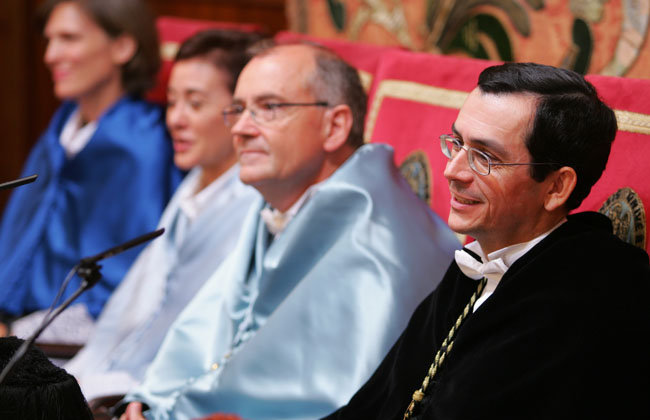
-
2006
New building at campus in San Sebastian
In March, the Prince and Princess of Asturias inaugurated the Telecommunications and Microelectronics research and teaching centre at Campus Tecnológico, located in Miramón. One hundred engineers will be doing research there in the areas of bioengineering applied to medicine, digital radio and ADSL, among others.
In October, the activities of the Entrepreneurs Club, promoted by FEUN and supported by Alumni, will begin, aimed at students from all degree programmes.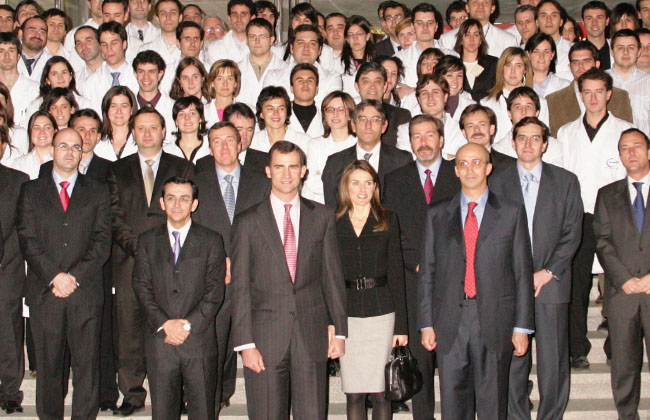
-
2007
New campus of IESE in Barcelona and advances in the patents for the CIMA
The King and Queen of Spain inaugurate IESE's new 30,000 square metre building campus in Barcelona.
In addition, the Ministry of Health authorises human trials of the first of the 30 patents of CIMA.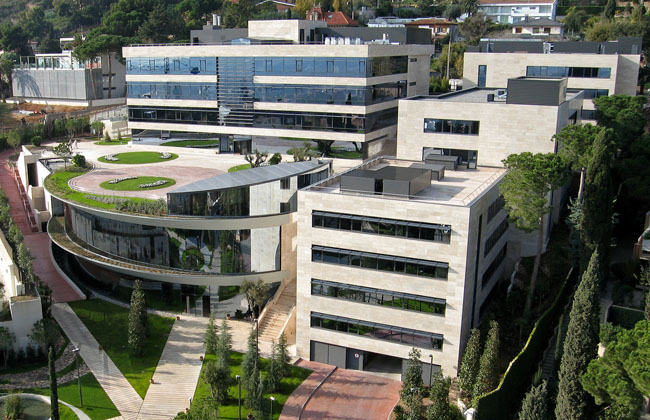
-
2008
Gold Medal to four teachers and donation by María Josefa Huarte
The School of Medicine adapts its Study program to the European Higher Education Area (EHEA) Education .
María Josefa Huarte donates her private collection of contemporary art to the University, with works by Picasso, Rothko, Palazuelo, Oteiza and Chillida, among others.
Four new Gold Medals are awarded to Mª Pilar Fernández Otero, Natalia López Moratalla, Carlos Cavallé and Lucas Mateo-Seco.
The Institute for Culture and Society is constituted. That same year, a call for expressions of interest for interdisciplinary research projects was made at Humanities and Social Sciences, and 25 proposals were received.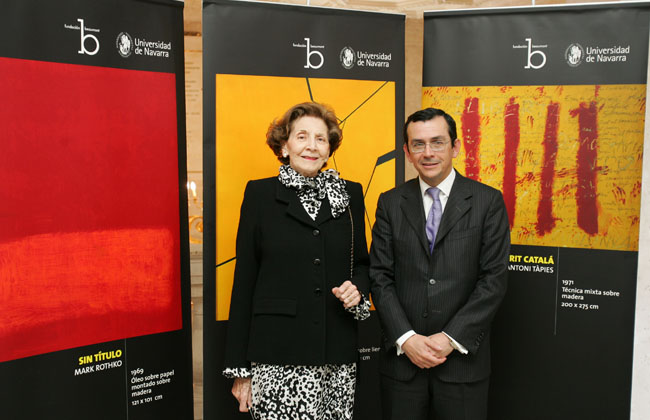
-
2009
New Degrees adapted to the EHEA
The University has submitted 31 degrees from Degree to committee of Universities for verification. Once their adaptation to the European Higher Education Area has been approved, they will begin to be offered in the 2009/10 academic year. Among the degrees presented, the new degrees in Bioengineering, Engineering in Industrial design and Product development , Building Engineering, the Masters in Early Childhood and Primary Education, and Biochemistry stand out.

-
2010
50th anniversary of the Friends' Association and new Gold Medal
The Friends' Association is celebrating its 50th anniversary. source The contribution of the Friends is an important source of funding for the University's research work and professor .
In December, María Teresa Igúzquiza, secretary to the last five rectors, was awarded the University's Gold Medal. It was the first time that this distinction was awarded to a member of the Administration and Services staff of the centre.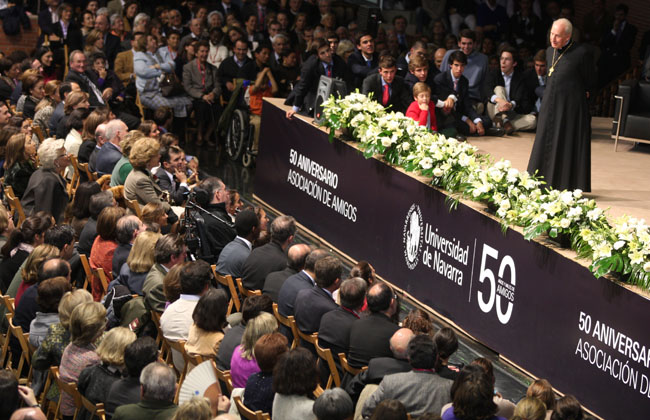
-
2011
International Excellence and new Honorary Doctors of Honour
The University obtains the qualification of Campus of International Excellence, from the Ministry of Education.
The School of Nursing, which began in 1954, becomes School. The ISEM Fashion Business School, based in Madrid, is established as a centre of the University.
On 27 October, Honorary Doctorates are awarded to Antonio López, Pèter Erdö, and Joseph Weiler.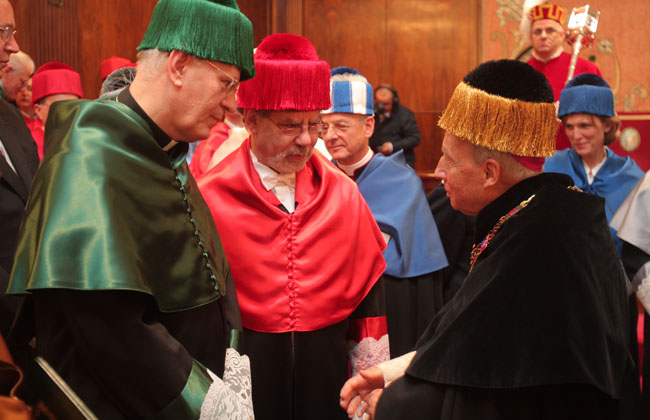
-
2012
New President, gold medals and the inauguration of the Amigos Building
Alfonso Sánchez-Tabernero, Full Professor of business Informative, is appointed President. He is the first who is also a former student.
submission At the opening ceremony, the University Gold Medal was awarded to José María Bastero, President between 1996 and 2005; and Francisco Errasti, director of CIMA.
In addition, the Amigos Building, which houses some services and the Schools Law and Economics, was inaugurated.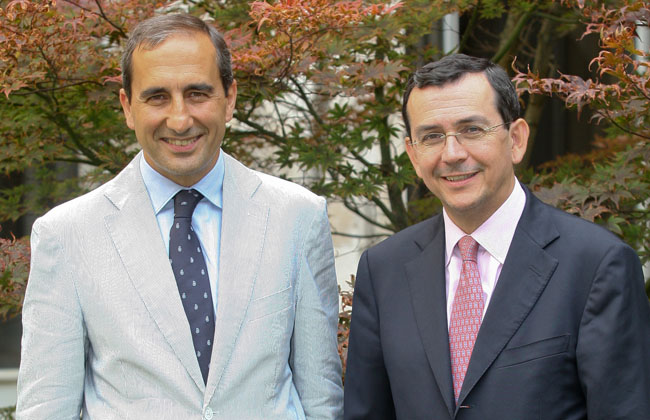
-
2013
ISSA's move to Pamplona and new School for Education and Psychology
ISSA begins to offer in Pamplona the Degree en attendance de Dirección-Management Assistance. The implementation of the four courses will be completed gradually. The move from San Sebastian coincides with the celebration of its 50th anniversary.
In addition, the growth of the School of Humanities and Social Sciences in recent years has led the University to approve a new School in Education and Psychology.
-
2014
Beatification of D. Álvaro and new headquarters of the Clinic in Madrid
In September, Don Álvaro del Portillo, the second Chancellor of the University, was beatified.
The Clínica Universidad de Navarra begins construction work on its new headquarters in Madrid. The new hospital is expected to begin its healthcare activity at the end of 2016. Since 2004, the Clinic had already been providing care in Madrid at a new site, provisional.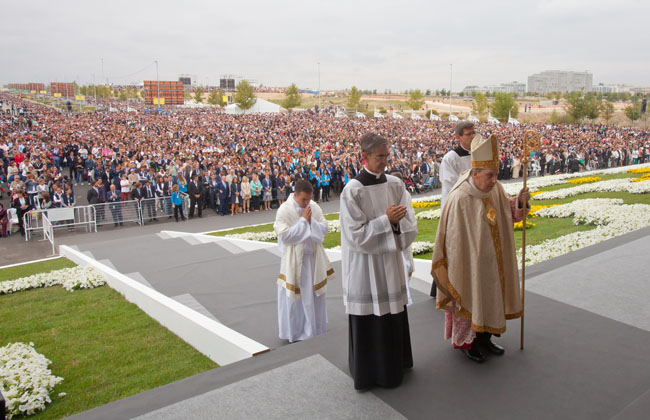
-
2015
Inauguration of the Museum of the University of Navarra
King Felipe and Queen Letizia preside over the inauguration of the University Museum of Navarre, designed by the architect Rafael Moneo, on their first official trip to Navarre as monarchs. The Museum begins its programme with five exhibitions, a performance by the National Dance Company in the Theatre and a wide range of educational activities.
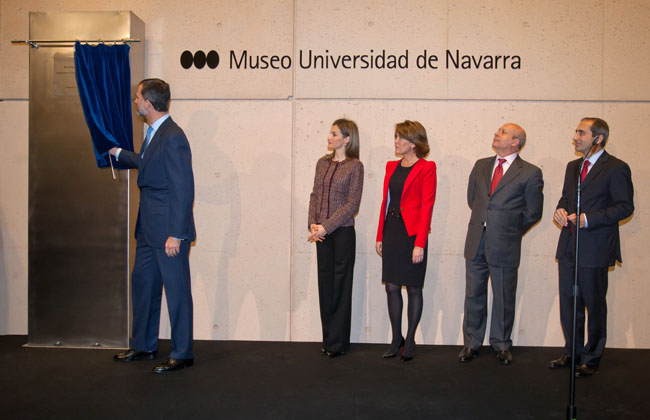
-
2016
Death of Chancellor, Monsignor Javier Echeverría
The University's Chancellor , Monsignor Javier Echevarría, died on 12 December 2016 in Rome at the age of 84. After the death of Blessed Don Álvaro del Portillo, he was elected and appointed by John Paul II as prelate of Opus Dei on 20 April 1994. Since then he has been Chancellor of the University. During these 22 years, he frequently visited Pamplona, taking an interest in the progress of the Schools, the research centres, the Museum...
-
2018
Inauguration of campus in Madrid
The President, Alfonso Sánchez-Tabernero, presides over the official inauguration of the new building of postgraduate program, which thus completes the project of campus that the University launched in November 2017 with the opening of the Clínica Universidad de Navarra.
In addition, the University was awarded the international award 'Green Flag Award', a recognition of the comprehensive management of its green spaces. The award ranked campus as one of the best parks in the world for the level of excellence in its management.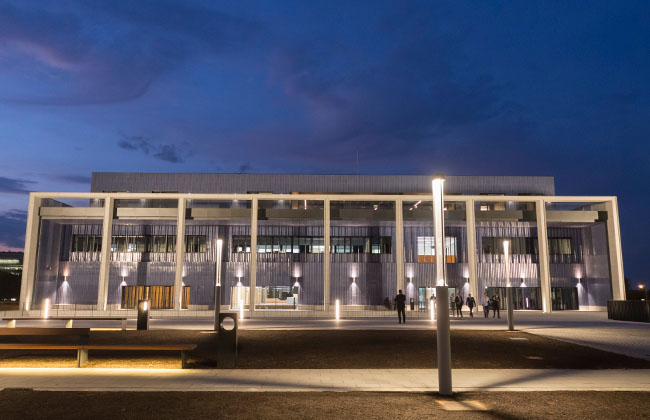
-
2019
New Honorary Doctors
The University awarded honorary doctorates to the Navarrese architect Rafael Moneo, the English sociologist Margaret S. Archer, the Hebrew philologist Ruth Fine and the expert in economics and media management Robert Picard. The ceremony was presided over by Chancellor, Fernando Ocáriz, and was held in the Museum Theatre, with around 700 people attending attendance .
That same year, the "THE Europe Teaching Rankings 2019" placed the University third in Europe in teaching, behind Oxford and Cambridge.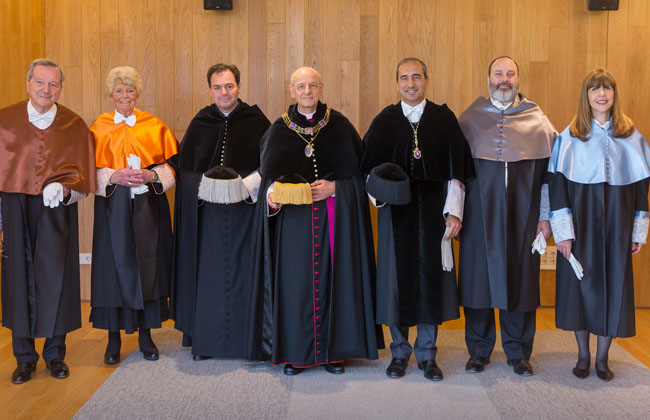
-
2020
COVID-19
Following the declaration of a state of alarm by the Spanish government, the University closed its campus in Pamplona, San Sebastian, Madrid and Barcelona, transferring its entire class activity to the digital environment.
For a safe return to campus, at the start of the new academic year 20/21, the University launched the Prepara2 plan, which included prevention and hygiene measures, innovative teaching and an increase in the aid programme for Degree and Master's students.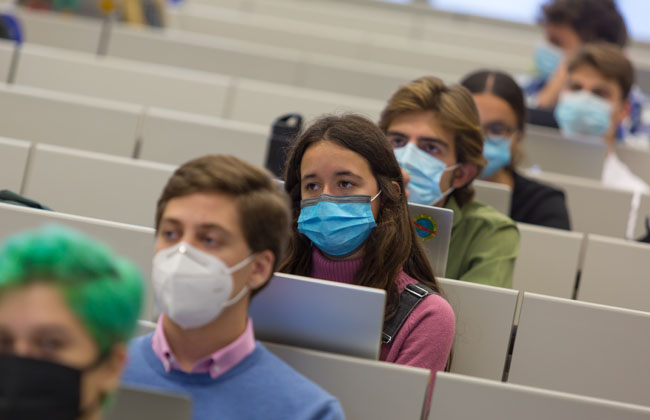
-
2021
María Iraburu, new president
On Chancellor, Monsignor Fernando Ocáriz appointed Professor María Iraburu Elizalde as the new president of the University. Professor Iraburu is the ninth person to occupy this position position.
thesis María Iraburu (Pamplona, 1964), a biologist from the University of Navarra, defended her doctoral dissertation at department of Biochemistry and Molecular Biology in 1992 and between 1993 and 1996 she spent a post-doctoral stay at the Albert Einstein College of Medicine in New York. In 1996 he joined the University. Since then, he has combined his degree program research with teaching and university governance.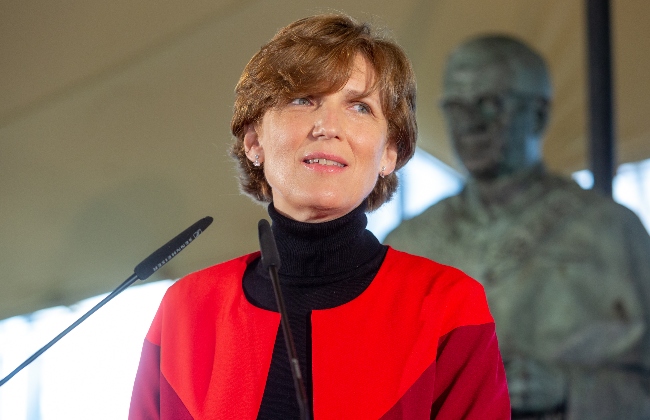
-
2022
The School of Engineering celebrates its 60th anniversary
The School of Engineering. Tecnun celebrated its 60th anniversary with the presence of professors, alumni, businessmen, researchers and representatives of institutions.
